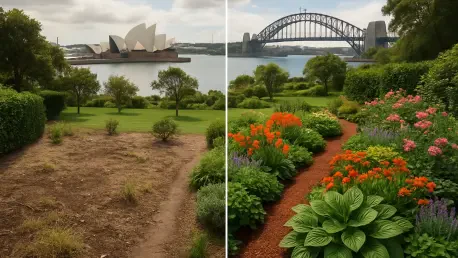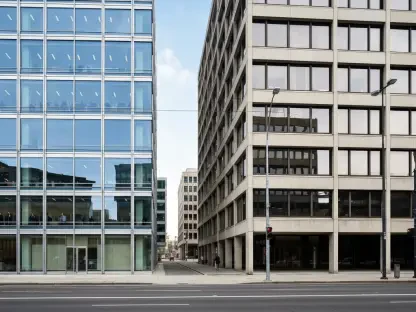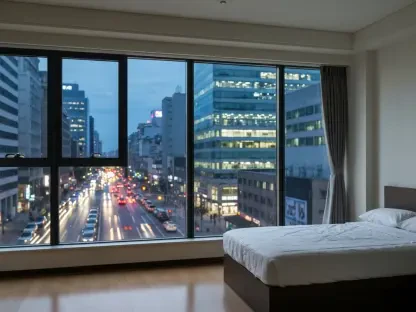Nestled in Sydney’s Eastern Suburbs, a residential property with breathtaking harbor views once languished in disconnection, its design failing to embrace the natural beauty surrounding it, and it remained isolated from the stunning Sydney Harbour backdrop. Built over two decades ago, the house and garden suffered from a rigid, formal layout that separated indoor spaces from the outdoors and ignored the potential of the picturesque setting. This narrative explores an extraordinary redesign project initiated several years ago, where architectural innovation and landscape mastery converged to breathe vibrant life into a once-sterile environment. The transformation tackled deep-seated challenges of layout and aesthetic, turning a disjointed space into a harmonious haven that celebrates both functionality and beauty.
The journey of this property’s revival reveals a meticulous process of breaking down barriers—both literal and figurative—to create a seamless flow between home and garden. A collaborative effort between Marston Architects, under the guidance of Pip Marston, and landscape designer Henry Chapple-Cox of Secret Gardens, set out to infuse the space with warmth and connectivity. Their vision was not just to renovate but to reimagine, crafting an inviting retreat that mirrors the dynamic energy of its urban harbor setting while offering a deeply personal escape. This story uncovers how strategic design decisions and site-specific solutions turned challenges into opportunities for lush, lasting impact.
Architectural Redesign: Breaking Down Barriers
Reorienting for Views and Flow
The architectural redesign addressed the property’s fundamental flaw: a complete lack of connection between living spaces and the surrounding environment. By relocating the main living areas to the first floor, the team at Marston Architects ensured that residents could engage with the rear garden and pool area while soaking in panoramic harbor views. This bold reconfiguration transformed daily life, making the Sydney Harbour Bridge a constant visual companion. Internal walls that once obstructed sightlines were removed, opening up the home into a fluid, airy expanse. The result was a space that felt integrated with its outdoor surroundings, allowing light and scenery to permeate every corner and fundamentally altering how the home interacted with its stunning location.
Beyond just spatial adjustments, this overhaul prioritized a sensory connection to the landscape. The repositioned living areas now served as a vantage point, offering unobstructed access to the garden’s evolving beauty and the harbor’s calming presence. This shift wasn’t merely structural—it was experiential, redefining how inhabitants moved through and perceived their home. The elimination of barriers created a dialogue between indoors and outdoors, where each space enhanced the other. Such a design choice reflected a commitment to maximizing the property’s inherent potential, ensuring that every glance outward became an invitation to engage with the natural and urban tapestry beyond the walls.
Simplifying with Lightness
The original facade of the home, marked by a heavy, boxy structure, underwent a dramatic simplification to shed its dated formality. Cantilevered steps were introduced, creating a floating aesthetic that imparted a sense of elegance and modernity to the exterior. This architectural lightness contrasted sharply with the prior rigidity, offering a visual reprieve that complemented the property’s new direction. The streamlined design not only modernized the home’s appearance but also laid a cohesive foundation for the garden’s transformation, ensuring that both elements shared a unified visual language of grace and openness.
This emphasis on lightness extended to material choices and structural details that softened the home’s once-imposing presence. The facade redesign incorporated subtle lines and minimalist features, reducing visual clutter and allowing the architecture to breathe. These changes created a backdrop that didn’t compete with the landscape but rather framed it, highlighting the harbor views and garden elements as integral parts of the living experience. By stripping away unnecessary complexity, the architectural team crafted a space that felt approachable yet sophisticated, setting the tone for a garden design that would echo this newfound sense of ease and harmony with its surroundings.
Landscape Overhaul: Crafting a Resilient Oasis
Overcoming Environmental Challenges
The garden’s redesign confronted a host of environmental obstacles, from shallow soils to the relentless western sun that baked the west-facing site. Henry Chapple-Cox approached these issues with pragmatic innovation, refurbishing the pool area with updated coping to improve both function and style. Steel planters were strategically added to increase soil depth where natural conditions fell short, supporting robust plant growth. A drip irrigation system was also integrated to ensure water efficiency, a critical consideration in an area prone to drought. Hardy, drought-tolerant species such as succulents and grasses were selected for their ability to endure the harsh conditions, creating a sustainable landscape that could thrive despite the site’s inherent limitations.
Additionally, the multi-level terrain posed a logistical challenge that required thoughtful intervention to unify disparate zones. Pathways were reconfigured to improve accessibility across the garden’s uneven layout, while structural enhancements like raised planters addressed the soil constraints head-on. These solutions didn’t just solve practical problems—they shaped a garden that felt intentional and resilient. The choice of plants was meticulously tailored to the microclimate, ensuring longevity without sacrificing aesthetic appeal. This approach demonstrated a deep understanding of the site’s demands, crafting an outdoor space that could withstand environmental stressors while maintaining a vibrant, green presence year-round.
Injecting Vibrancy and Movement
Departing from the garden’s former stiff formality—epitomized by a street-side tree once sculpted into a perfect cube—the new planting scheme embraced a looser, more dynamic style. Plants like Henkel’s yellowwood and blue switchgrass were chosen for their ability to sway gently in the breeze, introducing a sense of movement and life to the space. This shift brought an element of whimsy, softening the hard edges of concrete and stone structures while balancing the home’s angular architecture. The result was a garden that felt organic and spirited, a stark contrast to its previously constrained and lifeless design.
This focus on vibrancy extended to the interplay of textures and forms across the landscape. Layered plantings created depth, with taller grasses and trees providing structure while lower shrubs filled in gaps with color and softness. The deliberate selection of species that responded to wind and light added a temporal dimension to the garden, where each day offered a slightly different visual experience. Such design choices underscored a commitment to breaking free from static formality, crafting an outdoor environment that invited interaction and engagement. The garden became a living canvas, its elements constantly shifting in subtle, natural ways that mirrored the ebb and flow of the nearby harbor.
Connecting Spaces: Blurring Indoors and Outdoors
Building Physical Links
A pivotal element in uniting the home and garden was the installation of a hardwood deck, which acted as both a literal and symbolic bridge between spaces. Positioned near the pool and aligned with the upper living areas, this platform leveled the uneven terrain, creating a welcoming area for relaxation and socializing. New pathways and cantilevered concrete steps further enhanced connectivity, tying together the garden’s various levels into a cohesive whole. These structural additions ensured that moving between indoors and outdoors felt effortless, transforming the property into a single, integrated living environment.
The impact of these physical links went beyond mere accessibility—they reshaped the way the space was experienced. The deck, in particular, became a central hub where indoor comforts met outdoor beauty, fostering a seamless transition that encouraged daily use of the garden. Cantilevered steps echoed the home’s architectural theme of lightness, visually and functionally knitting the disparate zones together. This thoughtful design eliminated the previous sense of fragmentation, replacing it with a fluid layout that invited exploration and connection across every inch of the property, from interior rooms to the farthest garden nook.
Ensuring Privacy and Warmth
Given the property’s location in a densely built urban area, privacy emerged as a critical design concern that demanded creative solutions. Strategic hedging was employed to form natural barriers, shielding the garden from neighboring views without resorting to harsh, unwelcoming fences. Timber batten screens were also integrated, offering an additional layer of seclusion while contributing a warm, tactile element to the overall aesthetic. These features ensured the space felt like a private sanctuary, a quiet retreat amidst the bustle of city life.
Beyond their functional role, these privacy elements were carefully woven into the design to enhance the garden’s ambiance. The hedging softened the boundaries, blending seamlessly with the lush plantings to create a sense of enclosure that felt organic rather than imposed. Timber screens added visual interest, their natural tones complementing the hardwood deck and other materials used throughout the property. This balance of utility and style transformed potential drawbacks into design strengths, crafting an outdoor space that provided both solitude and a deep connection to its surroundings, harmonizing with the urban yet intimate setting.
Instant Impact: The Power of Mature Plantings
Rapid Transformation
One of the most remarkable aspects of this garden’s redesign was the immediacy of its transformation, achieved through the use of mature plants. These fully grown specimens were carefully craned into position, turning barren patches into thriving green spaces within mere days. Henry Chapple-Cox described this swift shift as a defining “light-bulb moment,” a testament to the emotional and visual impact of seeing a vision come to life so quickly. This approach bypassed the slow wait for growth, delivering a finished look that felt established from the outset.
The speed of this change had a profound effect on the property’s overall feel, instantly elevating it from a work in progress to a completed masterpiece. Mature plantings provided immediate scale and presence, filling the garden with texture and color that smaller plants would have taken years to achieve. This strategy not only met aesthetic goals but also underscored the meticulous planning behind the project, where every decision was geared toward maximum impact. The result was a space that felt timeless, as if it had always been a lush part of the harbor landscape, rather than a recent creation.
Balancing Form and Function
The selection of mature plants wasn’t solely about visual effect—it was a deliberate balance of form and function tailored to the site’s needs. At the front of the property, olive trees and agaves introduced sculptural beauty and a Mediterranean charm, anchoring the space with their striking silhouettes. Meanwhile, low shrubs and succulents were deployed in the tougher, sun-scorched areas, their resilience ensuring survival where other species might falter. Each plant choice was a calculated response to both environmental demands and design aspirations.
This dual focus on practicality and aesthetics ensured the garden served as both a functional outdoor space and a visual delight. The mature plantings created instant privacy and shade, addressing immediate needs while their varied forms added layers of interest across the landscape. Taller trees offered structure, while ground-level succulents softened hardscapes, weaving together a cohesive tapestry of greenery. Such thoughtful curation highlighted how design can adapt to challenging conditions without compromising on beauty, resulting in a garden that was as enduring as it was captivating.
A Unified Vision: Collaboration in Design
Shared Goals of Fluidity
The success of this transformation hinged on the seamless collaboration between Marston Architects and Secret Gardens, united by a common goal of fluidity over formality. Both teams sought to dismantle the property’s original rigid aesthetic, replacing it with a design that prioritized open-plan living and a natural indoor-outdoor flow. This shared vision ensured that architectural elements like floating steps mirrored the garden’s dynamic plantings, creating a harmonious dialogue between built and natural spaces. The result was a property that felt whole, each component enhancing the other.
This synergy extended to every detail, from spatial planning to material selection, ensuring consistency across the redesign. The architectural focus on lightness and connectivity directly informed the landscape’s emphasis on movement and accessibility, forging a space where neither element overshadowed the other. Such collaboration exemplified how integrated design can elevate a project, turning individual contributions into a singular, impactful outcome. The property became a testament to the power of shared intent, where every decision reinforced a collective commitment to livability and aesthetic harmony.
Reflecting Broader Trends
This redesign also mirrored wider shifts in urban design, particularly a growing emphasis on sustainability and environmental harmony in city settings like Sydney. Features such as water-efficient irrigation systems and climate-appropriate plant selections reflected a commitment to conservation, addressing the realities of local conditions. The project aligned with contemporary trends that favor naturalistic landscapes over manicured formality, prioritizing spaces that enhance daily life while respecting ecological constraints.
Furthermore, the focus on user-centric design—evident in the seamless indoor-outdoor integration—echoed a broader movement toward homes that serve as personal sanctuaries amidst urban density. The use of hardy, low-maintenance plants and thoughtful structural solutions like decks and screens spoke to a demand for practicality without sacrificing style. This transformation stood as a microcosm of evolving design philosophies, where livability, resilience, and connection to nature take precedence. It offered a blueprint for how urban properties can adapt to modern needs, balancing the demands of city life with the restorative power of green spaces.









